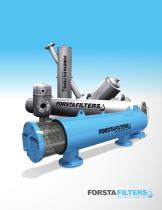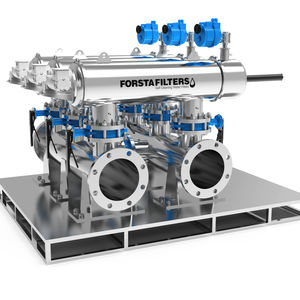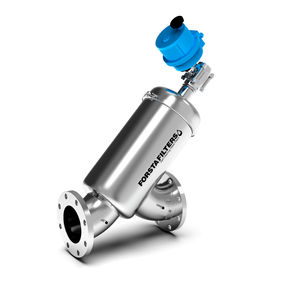
- Hydraulics - Pneumatics
- Filter and Separator
- Water filter
- Forsta Filters Incorporation
- Company
- Products
- Catalogs
- News & Trends
- Exhibitions
Water filter 180-FRPfiberglassprocessplastic






Add to favorites
Compare this product
Characteristics
- Designed for
- water
- Filtration element
- fiberglass
- Applications
- process
- Material
- plastic
- Mounting
- flange
- Cleaning
- self-cleaning
- Fluid specification
- for seawater
- Other characteristics
- horizontal, large, in-line
- Operating pressure
Min.: 35 psi
Max.: 150 psi
- Filtration size
Min.: 5 µm
Max.: 4,000 µm
- Flow
Min.: 15 us gal/min
(56.781 l/min)Max.: 4,500 us gal/min
(17,034.353 l/min)- Fluid temperature
150 °F
(65.6 °C)
Description
180-FRP Sea Water Filtration
180 FIBERGLASS REINFORCED PLASTIC (FRP) SERIES FILTERS – SEA WATER FILTRATION
The 180 Fiberglass Reinforced Plastic (FRP) Series filters offer an ideal solution for corrosion resistance in brackish, brine and seawater filtration applications. Fiberglass Reinforced Plastic, or Glass Reinforced Plastic (GRP) is a composite material or fiber-reinforced polymer made of a plastic reinforced by fine fibers made of glass.¹ All wetted components of the FRP Series self-cleaning filters are constructed from seawater- resistant plastic or other high alloy materials.
Forsta’s FRP Series self-cleaning water filters are available with an on-line, or in-line flange configuration to accommodate simple installation, and easily integrate with any pipeline in a seawater filtration process.
A two-stage screening distinguishes the FRP Series filters. A coarse screen is responsible for straining out large debris from the water source, and the fine screen purifies water to the designated micron rating.
Flow Rate - 15 - 4,500 gpm
Flush Cycle Duration - 6 - 20 seconds
Flush Valve Size - single 1″ or single 2″
Screen Opening - 5µ - 4,000µ
Temperature - 150ºF
Flush Volume - 15-110 gallons per backwash
Working Pressure - 35 - 150 psi
Catalogs
Forsta Filters Catalog
24 Pages
Other Forsta Filters Incorporation products
Filters and Strainers
Related Searches
- Liquid separator filter
- Filter for industrial applications
- Pressure separator filter
- Stainless steel separator filter
- Water separator filter
- Y-strainer filter
- Compact separator filter
- In-line filter
- Automatic separator filter
- Process separator filter
- High-efficiency pre-filter
- Screw-lock filter
- Self-backwashing filter
- Easy cleaning pre-filter
- High-performance pre-filter
- Flange-mount filter
- Fine filtration filter
- Separation filter
- High-efficiency separator filter
- Separator filter for the food industry
*Prices are pre-tax. They exclude delivery charges and customs duties and do not include additional charges for installation or activation options. Prices are indicative only and may vary by country, with changes to the cost of raw materials and exchange rates.









